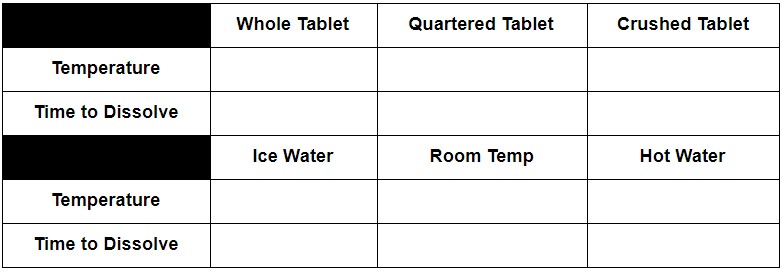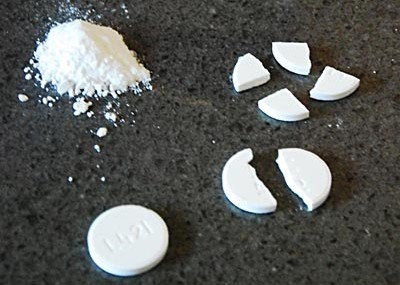The Alka Seltzer Reaction
Introduction & Motivation
Chemical reactions are one of the primary focuses for Chemical Engineers. From synthesizing polymers to treating water to creating fertilizers, chemical reactions are important in nearly every aspect of daily life. One job of Chemical Engineers is to classify, understand, and control these reactions to speed them up or slow them down.
Chemical reactions occur when bonds within molecules are broken or formed. There are several things that signify that a chemical reaction took place. These include a change in color, the production of a gas or solid, and of course a change in chemical composition. The starting chemicals before a reaction are called the reactants, and the chemicals that are produced are called the products. The reaction in this activity involves using sodium bicarbonate and citric acid to produce water and carbon dioxide.
Reaction: HCO3– (aq) + H+ (aq) → H2O (l) + CO2 (g)
The tablets contain sodium bicarbonate (NaHCO3) and citric acid. When the tablet is dissolved in water, bicarbonate (HCO3–) and hydrogen ions (H+) are formed. Once in solution, the two chemicals can then react according to the reaction listed above. For the reaction to occur, the HCO3– and H+ must collide at the right angle with the right amount of energy. The chances of this happening are better when the tablet is crushed into more pieces since the molecules have more opportunities to collide and when the temperature is higher, since the molecules are moving faster.
In this activity, students will experiment with the reaction between Alka Seltzer tablets and water in different conditions. By changing temperature and the surface area available for reaction, students will begin to see what factors chemical engineers can control to get the desired result.
This activity introduces the reaction used for the Alka Seltzer Rockets activity, so it is typically performed before building rockets to understand the nature of the reaction before using it.
Chemical Safety:
Materials
- Alka Seltzer tablets
- Water
- Ice
- Large beakers
- Food coloring
- Stopwatches
- Metal spoons
- Hot plates
- Stir rods
- Thermometers
- Wax Paper
Procedure
Before the experiment, ask students to hypothesize what will make the reaction go the fastest and what makes them think that. This can be anything, but try to seek answers with specific regard to the variables being changed in this activity.
The Effect of Temperature on Rate of Reaction
- Partially fill a large beaker with ice cubes. Fill the beaker with water up to the 250 mL mark with cold water and stir the ice water until the temperature equilibrates.
- Measure the temperature of the water and record it in the table.
- Add a tablet and record the time it takes for the tablet to react.
- Repeat 1-2 with room temperature water, then with hot water heated to 70 degrees C using a hot plate.
The Effect of Surface Area on Rate of Reaction
- Prepare three different sizes of the Alka Seltzer tablets:
- A whole tablet
- A tablet broken into quarters
- A tablet ground into powder: Place the tablet it a piece of weighing paper (wax or parchment paper work as well) and break it either with your hands or crush it using the back of a metal spoon.
- Add 250 mL of water to a large beaker.
- Measure and record the temperature of the water and make sure it is consistent between trials.
- One student should be ready with a stopwatch and another student should be ready with the whole tablet. The student with the stopwatch should count to three and on three start the stopwatch. At the same time, the other student should drop the tablet into the water.
- Gently stir the water at a consistent speed and pattern.
- As soon as the last of the tablet disappears, yell “Stop!,” stop the stopwatch, and record the time in the table.
- Repeat Steps 2-6 with the quartered tablet and the crushed tablet.

At the end, collect and present all class data on the board. Highlight discrepancies and the general trend.
Discussion
- Which combination of factors made the reaction go the fastest? The slowest? (Higher surface area and temperature make the reaction go faster. Since the reaction occurs on the surface of the tablet pieces, more access to it will make the reaction go faster because there are more molecules to make bumping together more likely. Higher temperature gives more energy to the molecules, meaning they are more likely to have enough energy for the reaction to continue. The opposite is true for the slowest rate – low surface area and temperature.)
- Why would we want reactions to happen faster or slower? (e.g. we want rusting reactions to be slower to protect metal products, but we want redox reactions that recharge our phone batteries to be fast.)
- Is there a limit to how fast we can make the reaction? Would we want to place a limit if there is not a physical one? (Reactions have maximum rates for a few reasons, like the amount of surface area available to react, if the mixture makes it difficult for molecules to move, etc. If the rate were increased too high, it becomes a safety concern! Sometimes reactions get too fast, too hot, and can’t be slowed down. This is a dangerous runaway reaction, the last thing a chemical engineer wants!)
- Why did any discrepancies come up in the data? What ways could we make our process better to limit those from affecting the class data as a whole? (Discrepancies come up from human error with measuring time, not having precise sizes of tablets, imprecise temperature control across trials, and how hard it is to see a reaction is finished! Let students get creative with suggesting improvements, but a few could include using a grid and knives to chop up tablets or putting the ground tablets through a sieve, using a robot to stir and observe the reaction, and putting the beakers in water baths.)
- We know Alka Seltzer is a medicine to make us feel better. Why might it be designed to fizz? (Fizzing helps the aspirin in the tablet quickly absorb into the bloodstream, making the medicine fast-acting. It might also make it more appetizing to drink!)

